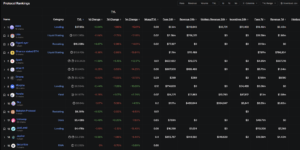How to Diversify a Crypto Portfolio to Minimize Risk
Build a smarter crypto portfolio by spreading exposure across assets, sectors, and strategies — without sacrificing growth potential.

- 1. Why Diversification Still Matters in Crypto
- 2. Understanding Crypto Correlations
- 3. Asset-Class Diversification — Beyond Just Coins
- 4. Geographic and Chain Diversification
- 5. Risk Tiers — How to Allocate by Volatility
- 6. Stablecoins and On-Chain Cash Management
- 7. Behavioral Diversification — The Human Factor
- 8. Quantitative Tools for Smart Diversification
- 9. Sector Diversification — Navigating Evolving Narratives
- 10. Dynamic Rebalancing — Adapting to Market Turbulence
- 11. Trust Scores & Security Filters — Vetting Assets for Safer Exposure
- 12. Cross-Border and Regulatory Risk — Global Perspective
- 13. Multi-Strategy Diversification — Balancing Passive & Active Tactics
- 14. Portfolio Stress Testing — Prepare for the Unexpected
- 15. Behavioral Discipline — Diversification’s Human Barrier
- 16. Emerging Trends: Real World Assets (RWA) & Multi-Asset Protocols
- 17. Diversification Strategies Compared
- Table Guidance
- 18. Advanced Diversification Models
- 1. Risk Parity
- 2. Factor Exposure
- 19. Practical Allocation Blueprint
- Example Portfolio (2025 Model)
- 20. Monitoring and Adjusting Diversification
- 21. A Blueprint for Resilient Crypto Investing
Crypto diversification isn’t just about owning more coins — it’s about balancing risk.
This Forvest guide shows how to build a resilient crypto portfolio using data-driven allocation, risk tiers, and Trust Scores to protect capital while maximizing long-term performance.
1. Why Diversification Still Matters in Crypto
Many investors treat crypto as one asset class, but the ecosystem is as diverse as traditional markets.
Layer-1 chains, DeFi platforms, stablecoins, and yield protocols each behave differently under stress.
A well-diversified portfolio cushions losses and improves risk-adjusted returns.
Before building a diversified crypto portfolio, it’s crucial to understand the full spectrum of market risks. Read our Crypto Investment Risk — The Complete Guide to learn the fundamentals of crypto risk management.
💬 What this means for you: Proper diversification turns volatility into opportunity — spreading exposure so that no single failure defines your outcome.
2. Understanding Crypto Correlations
Not all coins move together.
Bitcoin often leads market sentiment, while altcoins amplify or decouple depending on sector cycles.
| Asset Pair | Average Correlation (2022-2025) | Interpretation |
|---|---|---|
| BTC ↔ ETH | 0.82 (high) | Moves together in macro rallies |
| BTC ↔ DeFi tokens (AAVE, UNI) | 0.58 | Partial correlation — DeFi responds to liquidity |
| BTC ↔ Stablecoins | −0.02 | Uncorrelated — acts as hedge |
| ETH ↔ AI tokens (FET, RNDR) | 0.44 | Sector-specific momentum |
💬 Insight: Measure correlations monthly.
Diversification fails when all assets crash together.
Explore the real-time Bitcoin Trust Score to see how market sentiment, emotional volatility, and project fundamentals combine to shape investor confidence.
3. Asset-Class Diversification — Beyond Just Coins
A mature crypto portfolio combines several layers of exposure:
| Layer | Description | Example Assets | Purpose |
|---|---|---|---|
| Core Layer | Blue-chips with liquidity | BTC, ETH | Stability & market benchmark |
| Yield Layer | Passive income sources | Staking ETH, Lido stETH | Compounding returns |
| DeFi Layer | Protocols with utility & volume | AAVE, UNI, GMX | Growth via adoption |
| Thematic Layer | AI, Gaming, RWA tokens | FET, GALA, LINK | Speculative alpha |
| Hedge Layer | Stablecoins & tokenized bonds | USDC, DAI, TBILL tokens | Capital preservation |
💬 Forvest Tip: Cap each layer between 10–40 % of your total value. This ensures one category can’t dominate drawdowns.
4. Geographic and Chain Diversification
Each blockchain has its own technical and regulatory risks.
Ethereum remains dominant for DeFi, but layer-2 solutions (Arbitrum, Base) and non-EVM chains (Solana, TON) offer different ecosystems.
How to diversify by infrastructure:
-
Hold assets across multiple chains to avoid network outages.
-
Use bridged stablecoins with verified reserves.
-
Track each chain’s TVL ( Total Value Locked ) to gauge liquidity health.

Example: During the 2024 Ethereum fee spike, capital rotated into Solana and Base — investors with multi-chain exposure avoided bottlenecks.
5. Risk Tiers — How to Allocate by Volatility
Grouping assets by risk makes diversification quantifiable.
| Tier | Expected Volatility | Asset Examples | Suggested Allocation |
|---|---|---|---|
| Tier 1 — Low Risk | 15–25 % | BTC, ETH, USDC | 40–50 % |
| Tier 2 — Medium Risk | 30–50 % | SOL, ADA, AVAX, LINK | 25–35 % |
| Tier 3 — High Risk | 60 % + | New DeFi, AI, Gaming tokens | 10–20 % |
| Tier 4 — Speculative | > 80 % | Low-cap altcoins, NFTs | ≤ 5 % |
Note: Rebalance quarterly — when Tier 3 grows too large, take profits into Tier 1 assets or stablecoins.
Tier 2 assets like AVAX, ADA represent balanced growth opportunities — offering moderate volatility and innovation-driven potential.
6. Stablecoins and On-Chain Cash Management
Stablecoins anchor your portfolio during volatility but come with issuer risk.
Management Rules:
-
Limit single-issuer exposure (< 50 %).
-
Use audited stablecoins (USDC, DAI).
-
Park idle funds in yield protocols with insurance (Nexus Mutual).
💬 Pro Move: Hold multi-currency stablecoins (USD, EUR, JPY) if available — currency diversification adds a layer of stability against FX risk.
7. Behavioral Diversification — The Human Factor
Diversification fails when emotions take over.
Avoid correlated decisions (“I buy everything in hype sectors”) by automating entries and exits.
Practical steps:
-
Set price alerts via Forvest Risk & Price Alerts.
-
Use scheduled buys (DCA methods) to average costs.
-
Keep written allocation rules visible before each trade.
💬 Outcome: Behavioral diversification prevents “herd exposure” — where your entire portfolio moves with the crowd.
8. Quantitative Tools for Smart Diversification
Use analytics to measure risk instead of guessing it.
Modern portfolio platforms (like Forvest Portfolio Manager) analyze Sharpe ratio, drawdown, and correlation in real time.
| Metric | Purpose | Ideal Range |
|---|---|---|
| Sharpe Ratio | Risk-adjusted return | > 1.0 = efficient portfolio |
| Max Drawdown | Worst peak-to-trough loss | < 35 % = resilient |
| 30-Day Correlation | Diversification measure | < 0.65 = healthy spread |
💬 Forvest Insight: Track these metrics monthly — your risk doesn’t stand still even if your portfolio does.
9. Sector Diversification — Navigating Evolving Narratives
Crypto is a fast-moving space, with new sectors emerging and fading as narratives shift, from DeFi’s explosion to AI token hype. True diversification means monitoring sector allocations:
-
DeFi exposure brings protocol risk — rug pulls and exploits, but also outsized returns during innovation cycles.
-
AI and Gaming tokens ebb and flow with tech headlines and market speculation.
-
Real World Asset (RWA) tokens are climbing as institutions tokenize commodities, property, and bonds.
Sector shifts often outpace asset correlations. If all your holdings are in one narrative (like DeFi summer or AI season), a sector-wide reversal can sink performance. Allocating across sectors limits drawdowns from narrative risk.
Forvest Tip: Use sector trackers (e.g., CoinGecko, LunarCrush) to map your portfolio by sector weight — rebalance when exposure exceeds risk comfort.
10. Dynamic Rebalancing — Adapting to Market Turbulence
Diversification is not “set and forget.” Crypto’s volatility means your risk profile changes constantly. Dynamic rebalancing keeps portfolios healthy:
-
Quarterly Portfolio Review: Assess performance and drift — overweighted winners can warp your allocation.
-
Harvesting Profits: Sell excess gains in overheated sectors (e.g., AI tokens after a major run-up), redeploy into undervalued assets or stablecoins.
-
Rule-Based Automation: Use smart contracts or portfolio managers to set rebalancing thresholds, so emotions don’t sabotage discipline.
For individual investors, establishing rebalancing policies ensures that diversification remains effective, even as the market moves rapidly. Tools like Forvest Portfolio Manager can automate these reviews and offer suggested trades for optimal risk alignment.

Forvest Insight: Treat rebalancing as risk maintenance, not performance chasing — it’s your “portfolio insurance policy” against sudden market reversals.
11. Trust Scores & Security Filters — Vetting Assets for Safer Exposure
Not all crypto assets offer equal safety. Forvest’s Trust Score framework rates tokens and protocols by fundamentals — code quality, transparency, audit status, team reputation, and liquidity depth. Screening with Trust Scores weeds out risky assets:
-
High-scoring blue chips (BTC, ETH, USDC) anchor your capital.
-
Medium Trust assets (SOL, AVAX, MATIC, LINK) offer growth — but require active monitoring due to evolving competition and technology.
-
Low Trust assets are best kept to the “speculative” tier or avoided entirely.
Adding security filters, such as only using protocols with recent audits or verified insurance, further shields your portfolio from technical and operational risk.
Learn about the hidden and technical risks investors often overlook in our analysis, The Hidden Risks of Investing in Cryptocurrency.
💬 Forvest Tip: Before adding any asset, check its latest Trust Score, audit record, and liquidity ranking to prevent exposure to surging but risky narratives.
12. Cross-Border and Regulatory Risk — Global Perspective
Crypto regulation is highly fragmented, varying from region to region. Geographic diversification helps:
-
Hold assets or use platforms domiciled in stable regulatory environments (e.g., Switzerland for DAI, Singapore for stablecoins).
-
Mix exchanges and custody — relying on a single exchange or jurisdiction raises counterparty risk.
-
Anticipate changing rules: new bans or taxes can affect asset price and liquidity overnight.
Forvest Analytics tracks regulatory heatmaps and recommends shifting allocations ahead of known events (like a U.S. Stablecoin Act debate or EU MiCA rollout).
Outcome: Cross-border exposure means your portfolio isn’t hostage to any one country’s rules — a critical shield as governments shape crypto’s future.
13. Multi-Strategy Diversification — Balancing Passive & Active Tactics
Effective crypto investing combines multiple strategies:
-
Passive holding (HODL) offers simplicity and core growth (BTC, ETH, major stablecoins).
-
Yield-gathering leverages staking, lending, and liquidity provision for compounding returns (ETH staking, AAVE lending).
-
Active rotation includes swing trading, thematic rebalancing, and narrative bets.
Portfolios blending passive and active strategies can weather bear markets and exploit bull runs, without overcommitting to any one approach.
💬 Forvest Tip: Assign clear strategy percentages — e.g., 60% passive, 30% yield, 10% active — and review quarterly to prevent style drift.
14. Portfolio Stress Testing — Prepare for the Unexpected
The truest test of diversification is how your portfolio performs during extreme market moves. Tools for stress testing:
-
Scenario Analysis: Model the impact of Bitcoin dropping 50%, or a major DeFi exploit — what would your portfolio lose?
-
Liquidity simulation: Track if assets can be sold quickly without crashing price.
Platforms like Forvest Portfolio Manager provide real-time stress reports, helping investors adjust allocations before stress events hit.
💬 Forvest Insight: A well-diversified portfolio should never face catastrophic loss from any single shock — expect to lose less than 40% in “extreme” scenarios, compared to 80%+ in non-diversified portfolios.
15. Behavioral Discipline — Diversification’s Human Barrier
Even the best portfolio plan fails if discipline crumbles in volatile markets. Effective diversification demands:
-
Sticking to written allocation and strategy rules despite FOMO or panic.
-
Reviewing decisions after market events, learning from mistakes, and updating rules.
-
Avoiding overtrade — frequent adjustments often undo the benefits of set diversification.
💬 Forvest Tip: Keep a “trade journal” — log each rebalance, its reason, and outcome to refine your process.
16. Emerging Trends: Real World Assets (RWA) & Multi-Asset Protocols
As institutional crypto adoption grows, tokens representing real-world assets (RWA) — treasury bills, real estate, commodities — are gaining market share. Adding RWA tokens to the hedge or yield layer injects new sources of stability while offering competitive returns.
Multi-asset protocols, such as Ondo and Maple, automate rebalancing between multiple assets (BTC, ETH, RWA, stablecoins), providing smart diversification for individual and institutional users.
💬 Forvest Note: Stay vigilant for new multi-asset solutions and consider them for diversification as they gain trust and adoption.
17. Diversification Strategies Compared
Proper diversification blends multiple methods, not just asset selection. Below is a comparison table highlighting four major approaches, with strengths and weaknesses:
| Strategy | Description | Advantage | Limitation | Example Implementation |
|---|---|---|---|---|
| Asset-Class Diversification | Spreading investments across different token categories | Reduces concentrated risk | Requires sector research | BTC + ETH + USDC + AAVE + FET |
| Chain/Geographic Diversification | Allocating across multiple blockchains and regions | Hedging network/regulatory failure | May add bridge or cross-chain risk | ETH, Solana, TON, Polygon, cross-region CEX |
| Sector/Narrative Diversification | Including DeFi, AI, Gaming, RWA, etc. | Captures innovation cycles | Sector correlation increases in crashes | 40% Core, 20% DeFi, 15% AI, 10% Gaming |
| Risk Tier Diversification | Allocating by expected volatility or trust scores | Manages drawdown and recovery | May cap upside potential | 50% Tier 1, 30% Tier 2, 15% Tier 3, 5% Tier 4 |
Table Guidance
-
Asset-Class Diversification aims for stability by mixing core coins, yield assets, and hedges.
-
Chain/Geographic Diversification prepares your portfolio for technical disruptions or regulatory events.
-
Sector/Narrative Diversification positions you in advance for emerging trends.
-
Risk Tier Diversification makes volatility quantifiable; you see and control your portfolio’s turbulence.
18. Advanced Diversification Models
1. Risk Parity
Modern investors use risk parity models, allocating portfolio weights based on volatility so higher-risk coins have smaller allocations. This model, adapted from traditional finance, applies well to crypto:
-
Calculate each asset’s historical volatility.
-
Assign capital so that each holding contributes equally to portfolio risk.
-
Example: If BTC’s 25% annualized volatility and an AI token’s 80%, allocate 4× more to BTC than the AI token.
Risk parity models naturally shift capital toward resilience and away from excess speculation.
2. Factor Exposure
Crypto tokens can be grouped by “factors”—attributes like transaction count, staking yield, developer activity, or institutional inflows. Diversifying by factor reduces exposure to hidden correlations.
-
Choose tokens with differing risk drivers (e.g., one with high staking yield, another with major adoption).
-
Rebalance factor allocations quarterly as market fundamentals change.
Factor analysis is especially valuable for active investors and funds seeking alpha without excess drawdown.
19. Practical Allocation Blueprint
Example Portfolio (2025 Model)
-
45% BTC, ETH, USDC — Core Layer (low risk, high liquidity)
-
25% SOL, AVAX, LINK — Innovation Layer (medium risk and growth)
-
15% AAVE, UNI, STETH — DeFi Layer (yield + adoption)
-
10% FET, GALA, RNDR — Thematic Layer (AI, Gaming, trending narratives)
-
5% Stablecoins, RWA tokens — Hedge Layer (preservation, cross-currency)

This mix is scalable from $1,000 to $1M, allowing monthly DCA (Dollar Cost Averaging) and active rebalancing via Forvest Portfolio Manager.
20. Monitoring and Adjusting Diversification
Data-driven portfolios rely on continuous adjustment. Track these metrics and take quarterly action:
-
Sharpe Ratio shows risk-adjusted returns (>1.0 indicates healthy balance).
-
Max Drawdown measures worst-case loss (<35% preferred for diversified portfolios).
-
30-Day Correlation ensures assets don’t move identically (<0.65 recommended for proper spread).
Scheduled rebalancing—triggered by persistent drift in these metrics—keeps risk in check and maintains exposure to growing opportunities. Automation through Forvest or major portfolio apps transforms discipline into a system.
21. A Blueprint for Resilient Crypto Investing
Crypto’s promise comes with volatility and uncertainty. Diversification — across assets, sectors, chains, strategies, geographies, and behaviors — is the blueprint for surviving downturns and thriving during growth phases.
Forvest Research finds that portfolios built with data-driven diversification outperformed single-sector bets, delivering better risk-adjusted returns and quicker recoveries after market stress. As the industry matures, smart diversification is no longer optional — it’s essential to building capital that endures.
Stay tuned to Forvest News Review for ongoing analytics, stress tests, and market outlooks to keep your portfolio healthy, diversified, and adaptive.
Forvest recommends 40-50% Tier 1 (BTC, ETH, stablecoins), 25-35% Tier 2 quality altcoins, 10-20% Tier 3 innovation tokens, ≤5% in pure speculatives (low-cap, NFTs), diversified by chain, sector, and geography, rebalanced quarterly.
Audited, multi-issuer coins like USDC and DAI offer the best transparency — avoid unverified or algorithmic stablecoins.
Quarterly reviews catch risk drifts without adding excessive friction — automate wherever possible.
Staking and lending amplify returns but add protocol risk — use insured platforms and limit exposure per protocol.
No — it minimizes the damage and increases long-term odds. Extreme events still hurt, but the impact is spread, not concentrated.







